Martin Wattenberg
Does visualization help AI understand data?
Jul 24, 2025Abstract:Charts and graphs help people analyze data, but can they also be useful to AI systems? To investigate this question, we perform a series of experiments with two commercial vision-language models: GPT 4.1 and Claude 3.5. Across three representative analysis tasks, the two systems describe synthetic datasets more precisely and accurately when raw data is accompanied by a scatterplot, especially as datasets grow in complexity. Comparison with two baselines -- providing a blank chart and a chart with mismatched data -- shows that the improved performance is due to the content of the charts. Our results are initial evidence that AI systems, like humans, can benefit from visualization.
Can Interpretation Predict Behavior on Unseen Data?
Jul 08, 2025Abstract:Interpretability research often aims to predict how a model will respond to targeted interventions on specific mechanisms. However, it rarely predicts how a model will respond to unseen input data. This paper explores the promises and challenges of interpretability as a tool for predicting out-of-distribution (OOD) model behavior. Specifically, we investigate the correspondence between attention patterns and OOD generalization in hundreds of Transformer models independently trained on a synthetic classification task. These models exhibit several distinct systematic generalization rules OOD, forming a diverse population for correlational analysis. In this setting, we find that simple observational tools from interpretability can predict OOD performance. In particular, when in-distribution attention exhibits hierarchical patterns, the model is likely to generalize hierarchically on OOD data -- even when the rule's implementation does not rely on these hierarchical patterns, according to ablation tests. Our findings offer a proof-of-concept to motivate further interpretability work on predicting unseen model behavior.
When Bad Data Leads to Good Models
May 07, 2025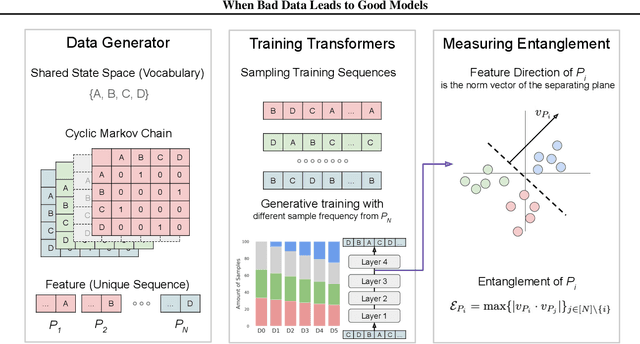
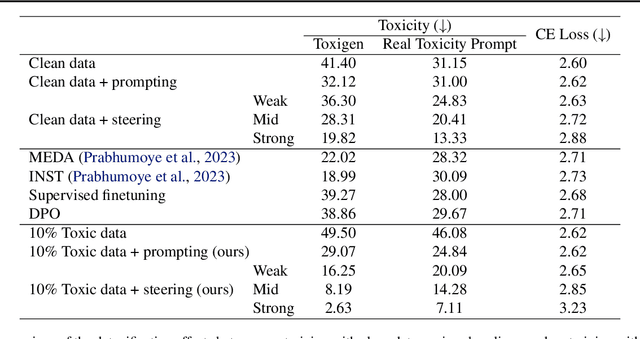
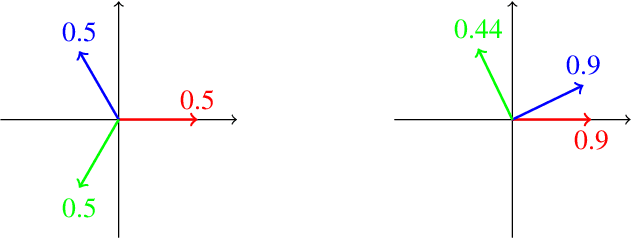
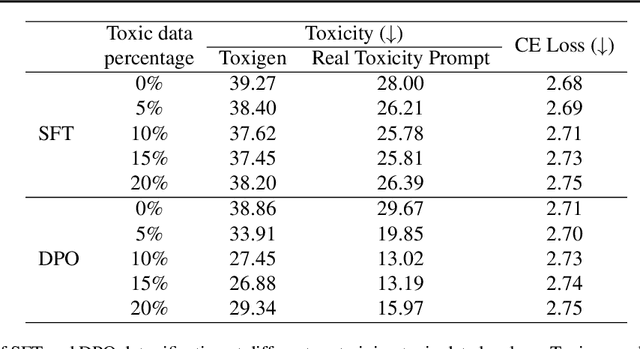
Abstract:In large language model (LLM) pretraining, data quality is believed to determine model quality. In this paper, we re-examine the notion of "quality" from the perspective of pre- and post-training co-design. Specifically, we explore the possibility that pre-training on more toxic data can lead to better control in post-training, ultimately decreasing a model's output toxicity. First, we use a toy experiment to study how data composition affects the geometry of features in the representation space. Next, through controlled experiments with Olmo-1B models trained on varying ratios of clean and toxic data, we find that the concept of toxicity enjoys a less entangled linear representation as the proportion of toxic data increases. Furthermore, we show that although toxic data increases the generational toxicity of the base model, it also makes the toxicity easier to remove. Evaluations on Toxigen and Real Toxicity Prompts demonstrate that models trained on toxic data achieve a better trade-off between reducing generational toxicity and preserving general capabilities when detoxifying techniques such as inference-time intervention (ITI) are applied. Our findings suggest that, with post-training taken into account, bad data may lead to good models.
The Geometry of Self-Verification in a Task-Specific Reasoning Model
Apr 19, 2025Abstract:How do reasoning models verify their own answers? We study this question by training a model using DeepSeek R1's recipe on the CountDown task. We leverage the fact that preference tuning leads to mode collapse, resulting in a model that always produces highly structured and easily parse-able chain-of-thought sequences. With this setup, we do a top-down and bottom-up analysis to reverse-engineer how the model verifies its outputs. Our top-down analysis reveals Gated Linear Unit (GLU) weights encoding verification-related tokens, such as ``success'' or ``incorrect'', which activate according to the correctness of the model's reasoning steps. Our bottom-up analysis reveals that ``previous-token heads'' are mainly responsible for model verification. Our analyses meet in the middle: drawing inspiration from inter-layer communication channels, we use the identified GLU vectors to localize as few as three attention heads that can disable model verification, pointing to a necessary component of a potentially larger verification circuit.
Shared Global and Local Geometry of Language Model Embeddings
Mar 27, 2025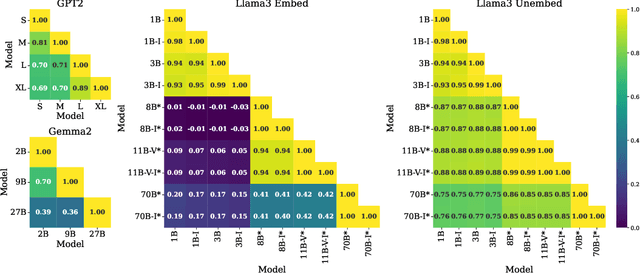
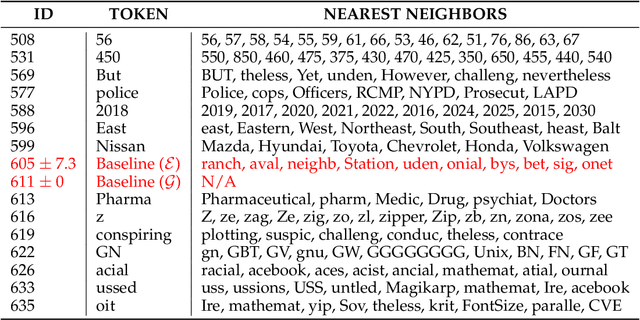
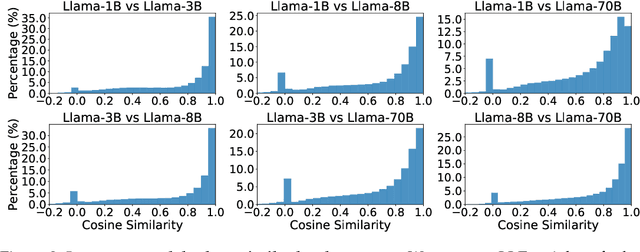

Abstract:Researchers have recently suggested that models share common representations. In this work, we find that the token embeddings of language models exhibit common geometric structure. First, we find ``global'' similarities: token embeddings often share similar relative orientations. Next, we characterize local geometry in two ways: (1) by using Locally Linear Embeddings, and (2) by defining a simple measure for the intrinsic dimension of each token embedding. Our intrinsic dimension measure demonstrates that token embeddings lie on a lower dimensional manifold. We qualitatively show that tokens with lower intrinsic dimensions often have semantically coherent clusters, while those with higher intrinsic dimensions do not. Both characterizations allow us to find similarities in the local geometry of token embeddings. Perhaps most surprisingly, we find that alignment in token embeddings persists through the hidden states of language models, allowing us to develop an application for interpretability. Namely, we empirically demonstrate that steering vectors from one language model can be transferred to another, despite the two models having different dimensions.
Archetypal SAE: Adaptive and Stable Dictionary Learning for Concept Extraction in Large Vision Models
Feb 18, 2025Abstract:Sparse Autoencoders (SAEs) have emerged as a powerful framework for machine learning interpretability, enabling the unsupervised decomposition of model representations into a dictionary of abstract, human-interpretable concepts. However, we reveal a fundamental limitation: existing SAEs exhibit severe instability, as identical models trained on similar datasets can produce sharply different dictionaries, undermining their reliability as an interpretability tool. To address this issue, we draw inspiration from the Archetypal Analysis framework introduced by Cutler & Breiman (1994) and present Archetypal SAEs (A-SAE), wherein dictionary atoms are constrained to the convex hull of data. This geometric anchoring significantly enhances the stability of inferred dictionaries, and their mildly relaxed variants RA-SAEs further match state-of-the-art reconstruction abilities. To rigorously assess dictionary quality learned by SAEs, we introduce two new benchmarks that test (i) plausibility, if dictionaries recover "true" classification directions and (ii) identifiability, if dictionaries disentangle synthetic concept mixtures. Across all evaluations, RA-SAEs consistently yield more structured representations while uncovering novel, semantically meaningful concepts in large-scale vision models.
Open Problems in Mechanistic Interpretability
Jan 27, 2025



Abstract:Mechanistic interpretability aims to understand the computational mechanisms underlying neural networks' capabilities in order to accomplish concrete scientific and engineering goals. Progress in this field thus promises to provide greater assurance over AI system behavior and shed light on exciting scientific questions about the nature of intelligence. Despite recent progress toward these goals, there are many open problems in the field that require solutions before many scientific and practical benefits can be realized: Our methods require both conceptual and practical improvements to reveal deeper insights; we must figure out how best to apply our methods in pursuit of specific goals; and the field must grapple with socio-technical challenges that influence and are influenced by our work. This forward-facing review discusses the current frontier of mechanistic interpretability and the open problems that the field may benefit from prioritizing.
ICLR: In-Context Learning of Representations
Dec 29, 2024



Abstract:Recent work has demonstrated that semantics specified by pretraining data influence how representations of different concepts are organized in a large language model (LLM). However, given the open-ended nature of LLMs, e.g., their ability to in-context learn, we can ask whether models alter these pretraining semantics to adopt alternative, context-specified ones. Specifically, if we provide in-context exemplars wherein a concept plays a different role than what the pretraining data suggests, do models reorganize their representations in accordance with these novel semantics? To answer this question, we take inspiration from the theory of conceptual role semantics and define a toy "graph tracing" task wherein the nodes of the graph are referenced via concepts seen during training (e.g., apple, bird, etc.) and the connectivity of the graph is defined via some predefined structure (e.g., a square grid). Given exemplars that indicate traces of random walks on the graph, we analyze intermediate representations of the model and find that as the amount of context is scaled, there is a sudden re-organization from pretrained semantic representations to in-context representations aligned with the graph structure. Further, we find that when reference concepts have correlations in their semantics (e.g., Monday, Tuesday, etc.), the context-specified graph structure is still present in the representations, but is unable to dominate the pretrained structure. To explain these results, we analogize our task to energy minimization for a predefined graph topology, providing evidence towards an implicit optimization process to infer context-specified semantics. Overall, our findings indicate scaling context-size can flexibly re-organize model representations, possibly unlocking novel capabilities.
Relational Composition in Neural Networks: A Survey and Call to Action
Jul 19, 2024Abstract:Many neural nets appear to represent data as linear combinations of "feature vectors." Algorithms for discovering these vectors have seen impressive recent success. However, we argue that this success is incomplete without an understanding of relational composition: how (or whether) neural nets combine feature vectors to represent more complicated relationships. To facilitate research in this area, this paper offers a guided tour of various relational mechanisms that have been proposed, along with preliminary analysis of how such mechanisms might affect the search for interpretable features. We end with a series of promising areas for empirical research, which may help determine how neural networks represent structured data.
Dialogue Action Tokens: Steering Language Models in Goal-Directed Dialogue with a Multi-Turn Planner
Jun 17, 2024

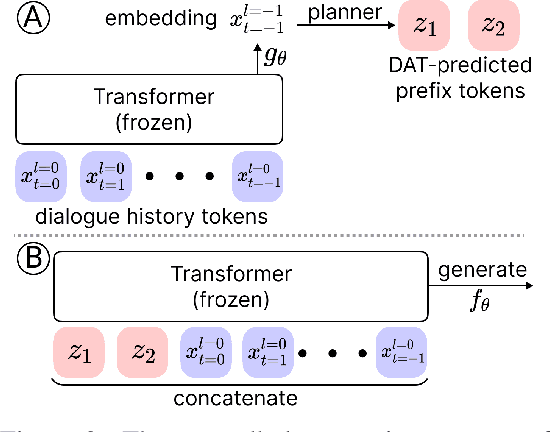

Abstract:We present an approach called Dialogue Action Tokens (DAT) that adapts language model agents to plan goal-directed dialogues. The core idea is to treat each utterance as an action, thereby converting dialogues into games where existing approaches such as reinforcement learning can be applied. Specifically, we freeze a pretrained language model and train a small planner model that predicts a continuous action vector, used for controlled generation in each round. This design avoids the problem of language degradation under reward optimization. When evaluated on the Sotopia platform for social simulations, the DAT-steered LLaMA model surpasses GPT-4's performance. We also apply DAT to steer an attacker language model in a novel multi-turn red-teaming setting, revealing a potential new attack surface.
 Add to Chrome
Add to Chrome Add to Firefox
Add to Firefox Add to Edge
Add to Edge